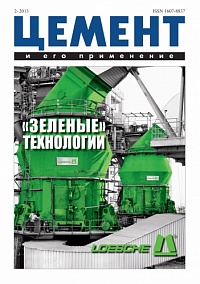Experimental studies and thermodynamic calculations of the kinetics of hydration of alite and ordinary Portland cement (PC) were carried out. It was shown that the gypsum content is a major factor in optimizing the hydration kinetics of alite, determining the ac...
Properties of mortars and concretes based on cements with high limestone content were identified. It was shown that purposeful grading harmonization of the main components of cement during its production is critical for the strength of the mortars. In the production of ...
The article addresses an important problem of developing optimal recipes for grouts based on PC 500-D0 and PCG 400-D0 cements produced by OOO Achinsk Cement and OOO Krasnoyarsk Cement, for jet grouting of slurry pits at the Achinsk Alumina Refinery.
The article describes the results of the study on the effect of organo-mineral additive Glenium ACE 430 — microsilica on cement paste hardening and the formation of stone structure and properties. The study identified the optimum additive making it possible to obtain ce...
The properties of cement pastes with different dispersive capacities of cement (200—600 m2/kg) and silica filler (100—900 m2/kg) were examined. It was found that after long curing in water (for 24 years) the cement stone with fine silica filler &...
Hereby work presents the development trends in cement technology. The proposed changes of cement production technology aim at the reduction of energy consumption and environmental impact, especially greenhouse gas emission, particularly CO2. Special attention has been p...
The environmental requirements on the fuel from municipal solid waste burnt in cement kilns are discussed. The article reviews foreign sources describing changes in the level of negative impact on the environment when fossil fuel is substituted with waste-based fuel.
The results obtained by Austrian A TEC Production & Services GmbH in the research of waste-based fuel (Refuse Derived Fuel — RDF) in the wet process kilns at ZAO Belgorod Cement are given. RDF treatment facilities at the existing municipal waste processing plant...
Cement industry contributes to the recycling of resources by using various industrial wastes and by-products in Japan. Therefore, the comprehensive materials design of cement, in consideration of both environmental impacts and properties, is expected to become increasin...
Possible uses of cements with several main components in the manufacture of precast concrete elements and their influence on the properties of the concrete are examined. The production of such cements exerts a lesser impact on the environment than that of the convention...


